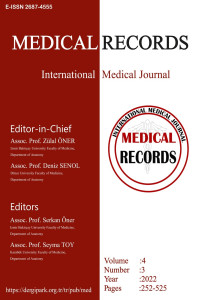Comparison of the Reliability of the “GÖK Atlas” and the “Gilsanz-Ratib Atlas” in the Determination of Bone Age in Turkish Children
Abstract
Aim: In this study we aimed to evaluate which of the GÖK and GR atlases is more compatible with chronological age in Turkish children aged 5-10 years.
Material and Method: In this study, the wrist radiographs of patients aged 5-10 years who applied to İzmir Bakırçay University Çiğli Training and Research Hospital due to trauma were retrospectively analyzed. A total of 360 wrist radiographs were evaluated. Bone age estimates in both groups were compared with chronological ages.
Results: In the correlation analysis, the prediction rate with 1-difference tolerance is 88.9% in the GR atlas and 76.7% in the GÖK atlas, while both atlases predict 99% correctly with two-difference tolerance. GR Atlas 168 (46.2%) and GÖK Atlas 147 (40.8%) predicted correctly regardless of gender and age. Of the correct estimations, 53.5% in the GR atlas and 57.8% in the GÖK atlas were male cases. İn male age group at the age of 6 and 10, the GR atlas is more successful, at the age of 7, the GÖK Atlas is more successful, and at the age of 5, 8, and 9 the success of both atlases is the same. İn female age group at the age of 5,7, 8, and 10 the GR atlas is more successful, at the age of 6 and 9 the GÖK Atlas is more successful
Conclusion: The GR Atlas was more accurate than the GÖK Atlas. Both the GR Atlas and the GÖK Atlas predicted more accurately in males. Since reference values for bone age can change with environmental and genetic factors all over the world, it is beneficial for all races to create atlas models with multicenter studies in order to establish their own standards.
Keywords
References
- 1. Buonasera T, Eerkens J, de Flamingh A, et al. A comparison of proteomic, genomic, and osteological methods of archaeological sex estimation. Sci Rep 2020;10:11897. 2. Zapico SC, Adserias-Garriga J. Estimation of sex based on postcranial elements in European American and Latin American populations. J Forensic Leg Med 2021;77:102098. 3. Toneva D, Nikolova S, Agre G, et al. Machine learning approaches for sex estimation using cranial measurements. Int J Legal Med 2021;135:951–966.
Türk Çocuklarında Kemik Yaşı Tespitinde “GÖK Atlas” ile “Gilsanz-Ratib Atlas“ın Güvenilirliğinin Karşılaştırılması
Abstract
Amaç: Bu çalışmada amacımız, 5-10 yaş arası Türk çocuklarında GÖK ve GR atlaslarından hangisinin kronolojik yaş daha uyumlu olduğunu araştırmaktı.
Materyal ve Metot: Çalışmada Bakırçay Üniversitesi Çiğli Eğitim ve Araştırma Hastanesi’ne travma nedeniyle başvuran 5-10 yaş arası hastaların sol el bilek grafileri retrospektif olarak incelendi. Toplamda 180 kız ve 180 erkek çocuğun el bilek grafileri uzman bir radyolog tarafından değerlendirilerek GR ve GÖK atlasları üzerinden kemik yaşı tayini yapıldı.Her iki gruptaki kemik yaşı tahminleri ile kronolojik yaşlar karşılaştırıldı.
Bulgular: Korelasyon analizinde 1 fark tolerans ile tahminleme oranı GR atlasında %88.9 GÖK atlasında %76.7 oranına ulaşmakta iken her iki atlas 2 fark tolerans ile %99 oranında doğru tahminlemede bulunmaktadır. Uyum analizinde cinsiyet ve yaştan bağımsız olarak GR Atlası 168 (%46.2) ve GÖK Atlası 147 (%40,8) doğru tahminde bulunmuştur. Doğru tahminlemelerin GR atlasında %53,5’i GÖK atlasında %57,8’i erkek olgulardır. Erkek olgularda 6 ve 10 yaşında GR atlası daha başarılı, 7 yaşında GÖK atlası daha başarılı, 5, 8 ve 9 yaşında ise her iki atlasın başarısı aynı idi. Kadın olgularda 5, 7, 8 ve 10 yaşında GR atlası daha başarılı, 6 ve 9 yaşında GÖK atlası daha başarılıydı.
Sonuç: GR Atlası, GÖK atlasından daha yüksek oranda doğru tahminlemede bulunmuştur. Hem GR Atlası hem de GÖK Atlası erkeklerde daha doğru tahminlemede bulunmuştur.Kemik yaşı referans değerleri tüm dünyada çevresel ve genetik faktörlerle değişebildiğinden, tüm ırkların kendi standartlarını oluşturabilmeleri için çok merkezli çalışmalarla atlas modelleri oluşturmalarında fayda vardır.
References
- 1. Buonasera T, Eerkens J, de Flamingh A, et al. A comparison of proteomic, genomic, and osteological methods of archaeological sex estimation. Sci Rep 2020;10:11897. 2. Zapico SC, Adserias-Garriga J. Estimation of sex based on postcranial elements in European American and Latin American populations. J Forensic Leg Med 2021;77:102098. 3. Toneva D, Nikolova S, Agre G, et al. Machine learning approaches for sex estimation using cranial measurements. Int J Legal Med 2021;135:951–966.
Details
| Primary Language | English |
|---|---|
| Subjects | Health Care Administration |
| Journal Section | Original Articles |
| Authors | |
| Publication Date | September 22, 2022 |
| Acceptance Date | June 1, 2022 |
| Published in Issue | Year 2022 Volume: 4 Issue: 3 |
Cited By
Adli Yaş Tahminine Yönelik Web of Science Veritabanında Yer Alan Araştırma Çalışmaların Bibliometrik Analizi
Harran Üniversitesi Tıp Fakültesi Dergisi
https://doi.org/10.35440/hutfd.1375401
Chief Editors
Assoc. Prof. Zülal Öner
Address: İzmir Bakırçay University, Department of Anatomy, İzmir, Türkiye
Assoc. Prof. Deniz Şenol
Address: Düzce University, Department of Anatomy, Düzce, Türkiye
E-mail: medrecsjournal@gmail.com
Publisher:
Medical Records Association (Tıbbi Kayıtlar Derneği)
Address: Düzce / Türkiye
Publication Support:
Effect Publishing & Agency
Phone: + 90 (553) 610 67 80
E-mail: info@effectpublishing.com


